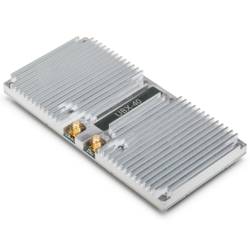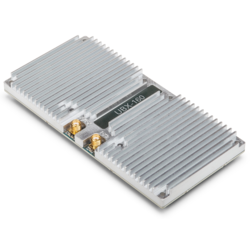Difference between revisions of "UBX"
(→RF Connectors) |
(→Drawings) |
||
| Line 267: | Line 267: | ||
==Mechanical Information== | ==Mechanical Information== | ||
===Drawings=== | ===Drawings=== | ||
| − | |||
| − | |||
* [[Media:cu ettus UBX cca.pdf| PDF Format]] | * [[Media:cu ettus UBX cca.pdf| PDF Format]] | ||
| − | |||
==RF Connectors== | ==RF Connectors== | ||
Revision as of 12:25, 11 July 2016
Contents
- 1 Device Overview
- 2 Key Features
- 3 Daughterboard Specifications
- 4 RF Specifications
- 5 Hardware Specifications
- 6 Environmental Specifications
- 7 USRP Compatibility
- 8 Schematics
- 9 Key Component Datasheets
- 10 Mechanical Information
- 11 RF Connectors
- 12 Certifications
- 13 Certificate of Volatility
- 14 Important Notes
- 15 RF Performance Data
- 16 Downloads
Device Overview
The UBX daughterboard is a full-duplex wideband transceiver that covers frequencies from 10 MHz to 6 GHz. Coherent and phase-aligned operation across multiple UBX daughterboards on USRP X Series motherboards enables users to explore MIMO and direction finding applications. The UBX daughterboard works interchangeably with other USRP daughterboards and is supported by the USRP Hardware Driver™ (UHD) software API for seamless integration into existing applications.
The UBX is capable of phase coherent operation, and therefore is suitable for MIMO and Phased Array applications, on the X Series. Additionally this capability is only available on the X Series devices.
Key Features
|
Daughterboard Specifications
Features
- 2 quadrature frontends (1 transmit, 1 receive)
- Defaults to direct conversion
- Can be used in low IF mode through lo_offset with uhd::tune_request_t
- Independent receive and transmit LO's and synthesizers
- Allows for full-duplex operation on different transmit and receive frequencies
- Can be set to use Integer-N tuning for better spur performance with uhd::tune_request_t
Antennas
Transmit: TX/RX
Receive: TX/RX or RX2
- Frontend 0: Complex baseband signal for selected antenna
- Note: The user may set the receive antenna to be TX/RX or RX2. However, when using a UBX board in full-duplex mode, the receive antenna will always be set to RX2, regardless of the settings.
Gains
- Transmit Gains: PGA0, Range: 0-31.5dB
- Receive Gains: PGA0, Range: 0-31.5dB
Bandwidths
- UBX: 40 MHz, RX & TX
- UBX-160: 160 MHz, RX & TX
Sensors
- lo_locked: boolean for LO lock state
LEDs
- LOCK: Synthesizer Lock Detect
- TX/RX TXD: Transmitting on TX/RX antenna port
- TX/RX RXD: Receiving on TX/RX antenna port
- RX2 RXD: Receiving on RX2 antenna port
RF Specifications
Freq Range
- 10MHz - 6GHz
Noise Figure
- 10 MHz - 500 MHz: 3 - 4 dB
- 500 MHz - 1.5 GHz: 2 - 3 dB
- 1.5GHz - 6GHz: 4 - 10 dB
RX IIP3 (Max)
- 10 MHz - 6 GHz: 8 - 9 dBm
RX IQ Imbalance
- 10 MHz - 6 GHz: < -30dBc
TX Power (Max)
- 10 MHz - 3 GHz: 20 dBm
- 3 - 6 GHz: 8 - 20 dBm
TX OIP3
- 10 - 500 MHz: 41 dBm
- 0.5 - 3 GHz: 36 dBm
- 3 - 6 GHz: 26 dBm - 36 dBm
TX IQ Imbalance
- 10 MHz - 6 GHz: < -30 dBc
Note: The UBX 160 transmitter path has 160 MHz of bandwidth throughout the full frequency range of the device; the receiver path has 84 MHz of bandwidth for center frequencies from 10 MHz to 500 MHz.
Hardware Specifications
- Ettus Research recommends to always use the latest stable version of UHD
UBX-40
- Current Hardware Revision: 1
- Minimum version of UHD required: 3.8.2
UBX-160
- Current Hardware Revision: 1
- Minimum version of UHD required: 3.8.2
Environmental Specifications
Operating Temperature Range
- 0-40 °C
Operating Humidity Range
- 10% to 90% non-condensing
USRP Compatibility
UBX-40
- N or X Series
UBX-160
- X Series only
Schematics
UBX
Key Component Datasheets
| Part Number | Description | Schematic ID (Page) |
|---|---|---|
| MAX2871 | Fractional/Integer-N Synthesizer/VCO | U3 (3); U9 (5); U19 (7); U23 (9) |
| ADL5375-05 | Quadrature Modulator | U22 (8) |
| LFCN-2250+ | Low Pass Filter | F1 (3); F24 (7); F34, F35 (10) |
| LTC5510 | Active Mixer | U15 (6) |
| LFCN-490+ | Low Pass Filter | F12 (5); F15 (6); F26 (7); F31 (9); F33, F36 (10) |
| HMC624LP4E | ATTENUATOR | U16 (6) |
| NBB-400 | Amplifier | U13 (6); U30 (11) |
| PHA-1+ | Amplifier | U31 (11) |
| ADA4927-2 | Differential ADC Driver | U6 (4) |
| ADL5380 | Quadrature Demodulator | U8 (4) |
| MGA-62563 | Low Noise Amplifier | U36 (11) |
| LFCN-1700+ | Low Pass Filter | F41 (11) |
| VMMK-3603 | Low Noise Amplifier | U34 (11) |
| LFCN-2600+ | Low Pass Filter | F14, F17 (6) |
| 855916 | SAW Filter | F16 (6) |
| LTC5510 | Active Mixer | U15 (6); U28 (10) |
| LFCN-2600+ | Low Pass Filter | F14, F17 (10) |
| TCM1-63AX+ | RF Transformer | T1 (3); T2, T3 (4); T7 (8) |
| ADA4927-2 | Differential ADC Driver | U6 (4) |
| AD8591 | Operational Amplifiers | U7 (4) |
| ADL5380 | Quadrature Demodulator | U8 (4) |
| ZXTC2062E6 | TRANSISTORS | Q1 (6) |
| HMC624ALP4E | ATTENUATOR | U16 (6); U29 (10) |
| LFCN-800+ | Low Pass Filter | F2 (3); F25 (7) |
| ADP7104-3.3 | CMOS LDO | U4, U5 (3); U10, U11 (5); U20, U21 (7); U24, U25 (9); U48 (13) |
| ADL5375-05 | Quadrature Modulator | U22 (8) |
| LTC5510 | Active Mixer | U28 (10) |
| 24LC024 | EEPROM | U38, U39 (12) |
| ADP7104-5.0 | CMOS LDO | U41, U42, U43, U44, U45, U46, U47 (13) |
| ZXTC2062E6 | TRANSISTORS | Q2, Q3, Q4, Q5 (13) |
Mechanical Information
Drawings
RF Connectors
- The UBX daughterboard features female SMA connectors for both the TX/RX and RX2 connectors.
Certifications
RoHS
As of December 1st, 2010 all Ettus Research products are RoHS compliant unless otherwise noted. More information can be found at http://ettus.com/legal/rohs-information
Certificate of Volatility
UBX-40/UBX-160
Important Notes
- A larger 24W (6V, 4A) power supply is required when using a UBX-40 daughterboard and integrated GPS Disciplined Oscillator accessory together in a USRP2, USRP N200, or USRP N210 device.
- The UBX-160 transmitter path has 160 MHz of bandwidth throughout the full frequency range of the device; the receiver path has 84 MHz of bandwidth for center frequencies from 10 MHz to 500 MHz.


